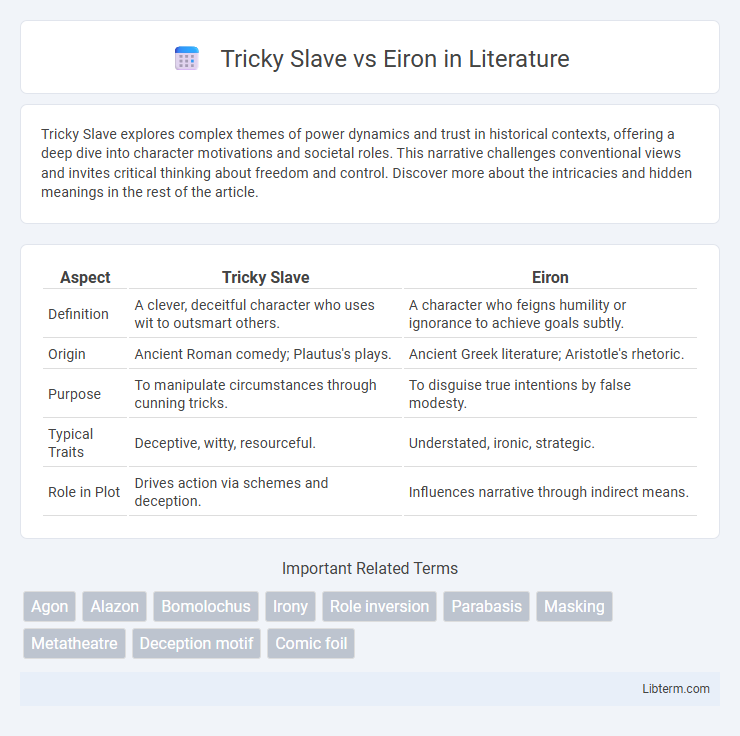Tricky Slave explores complex themes of power dynamics and trust in historical contexts, offering a deep dive into character motivations and societal roles. This narrative challenges conventional views and invites critical thinking about freedom and control. Discover more about the intricacies and hidden meanings in the rest of the article.
Table of Comparison
| Aspect | Tricky Slave | Eiron |
|---|---|---|
| Definition | A clever, deceitful character who uses wit to outsmart others. | A character who feigns humility or ignorance to achieve goals subtly. |
| Origin | Ancient Roman comedy; Plautus's plays. | Ancient Greek literature; Aristotle's rhetoric. |
| Purpose | To manipulate circumstances through cunning tricks. | To disguise true intentions by false modesty. |
| Typical Traits | Deceptive, witty, resourceful. | Understated, ironic, strategic. |
| Role in Plot | Drives action via schemes and deception. | Influences narrative through indirect means. |
Defining Tricky Slave and Eiron: Key Concepts
Tricky Slave and Eiron are pivotal figures in ancient Greek comedy, embodying distinct character archetypes with unique traits and narrative functions. The Tricky Slave, often portrayed as cunning and resourceful, uses clever schemes to manipulate other characters and drive the plot toward resolution. In contrast, the Eiron character employs understatement and feigned ignorance as a strategic form of irony to outwit opponents, highlighting intellect over brute force in classical literature.
Historical Origins of Tricky Slave and Eiron Archetypes
The Tricky Slave archetype originates from ancient Roman comedy, notably in Plautus' works, where clever slaves use wit and deception to outsmart their masters and resolve conflicts. The Eiron archetype, rooted in Greek Old Comedy, is characterized by a self-deprecating, understated figure who achieves victory through irony and modesty, contrasting with the boastful Alazon. Both archetypes play crucial roles in classical theater, highlighting social dynamics through humor and subversion.
Core Characteristics: Tricky Slave vs Eiron
The tricky slave archetype is characterized by cunning deception and subversive manipulation, often using wit to undermine authority. In contrast, the eiron relies on irony and self-deprecation to expose the foolishness of others, employing humor as a tool for social critique. Both figures leverage intelligence to navigate power dynamics but differ in approach: tricksters actively deceive, while eirons subtly reveal truths through understatement.
Roles in Ancient Greek Comedy
In Ancient Greek comedy, the Tricky Slave and the Eiron represent contrasting stock characters essential for plot development and humor. The Tricky Slave, often clever and resourceful, manipulates situations and other characters to achieve goals, embodying wit and cunning. The Eiron, by contrast, employs understatement and self-deprecation to deceive or undermine others, highlighting subtlety and irony in comedic narratives.
Literary Examples of Tricky Slave Figures
Tricky slave figures like Tricky Slave and Eiron exemplify cunning characters who manipulate social dynamics to achieve their goals. Tricky Slave, prominent in ancient Roman comedy, uses wit and deception to outsmart masters and rivals, as seen in Plautus's plays such as "Miles Gloriosus" where the clever slave traps the braggart soldier. Eiron, emblematic in Greek Old Comedy and Aristotle's poetics, employs understatement and irony to expose folly, notably in Aristophanes' "The Knights," highlighting social critique through subtle cunning.
Famous Eiron Characters in Literature
Eiron characters, known for their ironic understatement and self-deprecation, prominently appear in classical literature as figures who use wit to undermine arrogance and expose truth. Famous examples include Odysseus from Homer's *Odyssey*, whose cunning and subtle sarcasm contrast with the bluntness of the Tricky Slave archetype found in Roman comedy. The Eiron's sophisticated irony serves as a powerful tool in literary narratives to challenge social norms and highlight intellectual superiority.
Humor and Social Commentary: Tricky Slave vs Eiron
The Tricky Slave archetype uses cunning and deception to expose social hierarchies, offering sharp humor that critiques power dynamics in classical literature. The Eiron employs understatement and self-deprecation to mock pretentiousness, highlighting societal follies through subtle wit. Together, these figures deliver timeless social commentary by blending comedy with incisive observations on human behavior.
Evolution of the Archetypes in Modern Storytelling
Tricky Slave and Eiron archetypes have evolved significantly in modern storytelling, reflecting complex character motivations and moral ambiguities. The Tricky Slave, originating from ancient Roman comedy, often embodies cunning and subversion of social hierarchies, while the Eiron represents understated irony and self-deprecation to reveal deeper truths. Contemporary narratives blend these archetypes to create multi-dimensional characters who challenge traditional roles and emphasize psychological depth, social critique, and nuanced humor.
Psychological Perspectives: Motivation and Strategy
Tricky Slave in classical literature uses deception and cunning to manipulate outcomes, driven by survival instincts and social subversion motives. Eiron, characterized by understatement and self-deprecation, employs psychological strategy to undermine opponents by feigning ignorance while asserting control. Both personas reveal complex human behaviors reflecting adaptive intelligence and tactical interaction in social hierarchies.
Lasting Influence on Popular Culture
Tricky Slave and Eiron are archetypes rooted in ancient Greek comedy, influencing character development in literature and theater by embodying wit and deception. Tricky Slave represents clever servants who manipulate situations to their advantage, while Eiron disguises their abilities beneath a facade of humility or understatement, often deceiving stronger opponents. Their enduring presence is evident in modern storytelling, shaping characters in plays, novels, and films that explore cunning and social satire.
Tricky Slave Infographic

 libterm.com
libterm.com